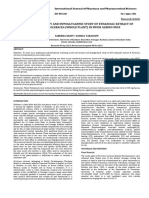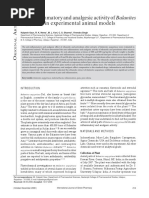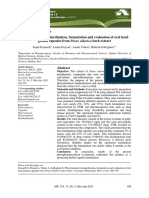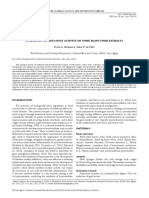IJPR Publication
IJPR Publication
Uploaded by
Manju VannaCopyright:
Available Formats
IJPR Publication
IJPR Publication
Uploaded by
Manju VannaOriginal Description:
Original Title
Copyright
Available Formats
Share this document
Did you find this document useful?
Is this content inappropriate?
Copyright:
Available Formats
IJPR Publication
IJPR Publication
Uploaded by
Manju VannaCopyright:
Available Formats
ISSN 0975-2366
DOI:https://doi.org/10.31838/ijpr/2021.13.03.229
Research Article
Antioxidant and antiparkinsonian potential of a
polyherbal formulation in 6-Hydroxydopamine
induced parkinsonism in rats
MANJUSHA VANNA1 *, VENKATACHALAM VELAPPAN VENKATACHALAM2, SURESH DIDAGI
KULKARNI1
1
Department of Pharmacology, Pullareddy Institute of Pharmacy, JNTU, Hyderabad, Telangana, India.
2
Department of Pharmacology, Annamalai University, Chidambaram, Tamil Nadu, India.
*Corresponding Author
Email: manjuvanna@gmail.com.
Received: 12.11.20, Revised: 22.12.20, Accepted:11.01.21
ABSTRACT
In the present study, ethanolic extract of Moringa concanensis (EEMC), ethanolic extract of Sesbania
grandiflora (EESG) and polyherbal formulation (PHF) prepared using different ratios of their aqueous extracts
had been studied for their neuroprotective effect against 6-Hydroxy dopamine (6-OHDA) induced
parkinsonism in rats. Forty-eight female Wistar albino rats were divided into eight groups containing six
animals each. Oxidative stress leading to neuronal damage similar to parkinson’s disease (PD) was induced in
all rats by intracerebro- ventricular administration of 6-OHDA (8 µg/2 µl/rat) a powerful neurotoxin using
stereotaxic apparatus. Then the aqueous extracts (AEMC and AESG) were prepared from the marc obtained
after ethanolic extraction and they were taken in different ratios to prepare PHF-A, B and C. Then the PD
induced rats were treated as follows: Gp-I:Normal control- saline; Gp-II: Disease control- 6-OHDA; Gp- III:
Standard- levodopa (6mg/kg, p.o); Gp-IV: Ethanolic extract of Moringa concanensis (EEMC, 400 mg/kg, p.o.);
Gp-V: Ethanolic extract of Sesbania grandiflora (EESG, 400 mg/kg, p.o.) and Gp-VI: PHF-A (50% AEMC: 50%
AESG) (500 mg/kg, p.o.); Group-VII: PHF-B (70% AEMC:30%AESG) (500 mg/kg, p.o.) and Gp-VIII: PHF-C (30 %
AEMC:70% AESG) (500 mg/kg, p.o.). Antioxidant status and dopamine level alterations due to 6-OHDA
induced oxidative stress were analysed. Treatment with EEMC, EESG, PHF-A, PHF-B and PHF-C were found
to significantly increase the Dopamine and improve antioxidant status in 6-OHDA- induced parkinsonism in
rats (*p<0.0001 and **p<0.05 were considered statistically significant). The present study proved that EEMC,
EESG, PHF-A, PHF-B and PHF-C were found to exhibit significant antiparkinsonian activity against 6-OHDA
induced parkinsonism in rats. However the activity in EESG-treated and PHF-C treated group was found to be
slightly lower compared to levodopa, EEMC, PHF-A and PHF-B treated groups.
Keywords: 6- Hydroxy dopamine; Moringa concanensis; Oxidative stress; Polyherbal formulation; Sesbania
grandiflora; stereotaxic apparatus.
INTRODUCTION: grandiflora comprises protein, minerals, Vitamin
Parkinsonism is a neurodegenerative disorder A, Folate, Thiamine, Niacin and Vitamin C. The
occuring mainly due to damage to dopaminergic seeds consist of phytoconstituents like
nigrostriatal neurons leading to muscular rigidity, leucocyanidin, cyanidin, Saponins and
dyskinesia, tremors etc.., The conventional Sesbanimide which exert antioxidant potential.
therapy available exerts several adverse effects The seeds of S. grandiflora were found to exert
which may affect patient compliance too. Our anti amnesic and anti Alzheimer’s activity
mother nature gifted us thousands of plants which (Semwal BC et al., 2018).
have significant medicinal properties. Leaves of Several studies suggested the promising effects of
Moringa concanensis nimmo, belonging to family Polyherbal formulations in treating various
Moringaceae was used in traditional medicine for neurological disorders like Alzheimer’s disease (K
treating various ailments like leucorrhoea, Sharath Kumar et al., 2016), Parkinson’s disease
spleenomegaly, infertility, diabetes, jaundice, (Anitha nandagopal et al., 2020), Epilepsy
blood pressure, high cholesterol etc.., The leaves (Ghosh A et al., 2016), stress (Bharathi KN et al.,
of M. concanensis consists of alkaloids, steroids, 2009), anxiety((Bharathi KN et al., 2009) and
flavanoids,Phenol, terpenoids which have amnesia(Shah JS et al., 2011). In this context, the
potential to exert neuroprotective activity (Santhi K present study aims at preparation and evaluation
et al., 2016). The seeds and leaves of Sesbania of a polyherbal formulation comprising leaf and
1597|International Journal of Pharmaceutical Research |Jul -Sep 2021 | Vol 13 | Issue3
Manjusha Vanna et al/ Antioxidant and antiparkinsonian potential of a polyherbal formulation in 6-
Hydroxydopamine induced parkinsonism in rats
seed extracts of M. concanensis and S. Acute toxicity study
grandiflora respectively. Acute toxicity studies of EEMC, EESG and Poly
Herbal Formulations –PHF-A, PHF-B and PHF-C
MATERIALS AND METHODS were performed in Swiss albino mice at dose
Collection and identification of plant material levels of 5, 50, 300 and 2000 mg/kg as per
The Leaves of Moringa concanensis and seeds of Organisation for Economic Co-operation and
Sesbania grandiflora were collected from local Development (OECD) 423 guidelines. Dose
gardens of Hyderabad. The collected plant calculation was done as per Karber’s method and
samples were identified and authenticated by Dr. 1/10 dose was selected for animal study.
A. Vijaya Bhaskar Reddy, Botanist, Osmania Experimental animals
University, Hyderabad. Forty-eight female Wistar albino rats weighing
Chemicals and reagents 200-250g were procured from Sainath agencies,
The neurotoxin 6-Hydroxy dopamine (6-OHDA) Hyderabad. All the animals were caged in clean
was procured from Sigma-Aldrich (USA). All the polypropylene containers and allowed free access
chemicals and reagents used for the study were of to standard pellet diet and water ad libitum. The
analytical grade and were acquired from local entire experimental study was approved by
Laboratory chemical suppliers at Hyderabad. The Committee for the purpose of control and
stereotaxic apparatus was purchased from supervision of experiments on animal (Reg. No.
Labindia Instruments Pvt. Ltd (Thane). 1534/PO/Re/S/2011/ CPCSEA). All Institutional
Preparation of ethanolic extracts of M. Animal Ethical Committee (IAEC) guidelines in
Concanensis (EEMC) and S. Grandiflora (EESG) accordance with CPCSEA were followed during
The separated leaves of M. concanensis and the entire protocol.
seeds of S. grandiflora were thoroughly rinsed Experimental design for animal study
with clean water to remove any dust or particulate Forty-eight Wistar albino rats were divided into
matter. Then they were dried under shade in a eight groups with six rats per group and were
room with sufficient airflow. They were frequently treated for seven days as follows:
turned to ensure proper drying. After this stage, Group I: Normal control - Received normal saline
the drugs were pulverized using a mixer. Then Group II: Disease control - Received 6-OHDA (8
500g of each drug was weighed and was µg/2 µl/rat) + Normal saline
subjected to soxhlet extraction using solvent Group III: Standard - Received 6-OHDA +L-
ethanol. The solvent was allowed to evaporate to DOPA (6 mg/kg, p.o.)
get the dried residue of extract. Group IV: 6-OHDA+ Ethanolic extract of
Preparation of polyherbal formulation Moringa concanensis (EEMC 400 mg/kg, p.o.)
The marc of EEMC and EESGwere taken in Group V: 6-OHDA+ Ethanolic extract of
separate round bottomed flasks. The menstrum Sesbania grandiflora (EESG 400 mg/kg, p.o.)
(500 ml of distilled water) was poured on top of Group VI: 6-OHDA+ Poly herbal formulation-A
drug material until it was completely covered and (500 mg/kg p.o.)
10 ml of chloroform (to prevent mould and Group VII: 6-OHDA+ Poly herbal formulation-B
fungus formation) was added to each flask. The (500 mg/kg p.o.)
mouth of the flask was properly covered with Group VIII: 6-OHDA+ Poly herbal formulation-C
aluminium foil and was left at room temperature (500 mg/kg p.o.)
for 7 days with occasional shaking. This method Induction of Parkinsonism using 6-Hydroxy
of extraction carried out at room temperature is dopamine (6-OHDA)
called “maceration”. At the end, the ‘marc’ was The 6-OHDA is a powerful neurotoxin employed
strained from the using muslin cloth, to get widely to evaluate anti-parkinsonian potential of
“micelle’; then the marc was again pressed to get several drugs. 30 min prior to surgery, all the rats
any solvent remains. The micelle and pressed out were treated with Desipramine to prevent nor-
solution were mixed, filtered using Whatmann adrenalinergic neuronal damage due to 6-
filter paper. The final filtrate was concentrated on OHDA. All animals were anaesthetized with
water bath maintained at < 500C to obtain ketamine (100mg/kg , i.p.), and placed on a
aqueous extract of M. Concanensis (AEMC) and stereotaxic apparatus. A burr hole was drilled in
aqueous extract of S. grandiflora (AESG). Then the skull and the needle was inserted into the
AEMC and AESG were taken in three ratios to substantia nigra with the following coordinates:
prepare PHF-A ( 50% AEMC: 50% AESG); PHF-B ( anterior/ posterior: -4.8 mm; medial/lateral: -2.2
70% AEMC:30% AESG) and PHF-C (30% mm; ventral/dorsal: -7.2 mm−3.5mm from
AEMC:70% AESG) bregma and injection of 6- OHDA (20 µg of 6-
OHDA hydrobromide in 4µl 0.9% saline with
0.02 µg/ml ascorbic acid) should be then made
1598|International Journal of Pharmaceutical Research |Jul -Sep 2021 | Vol 13 | Issue3
Manjusha Vanna et al/ Antioxidant and antiparkinsonian potential of a polyherbal formulation in 6-
Hydroxydopamine induced parkinsonism in rats
over 5 min and the needle should be left in place buffer (pH 7.4). Absorbance of mixture was
for a further 5 min. The bregma is located at the recorded at 420 nm (Weydert CJ et al., 2010).
point where coronal suture and the sagittal suture Determination of catalase activity
converge, it is the point where the frontal bone Sinha (1972) method was followed to assess
and parietal bones meet. Normal control group catalase (CAT) activity. Brain supernatant 10 %
rats were administered with vehicle (Michelle S. (100 μl) was added into the reaction mixture
Antunes et al., 2014). containing 0.2 M H2O2 (0.4 ml) and 0.01 M
Evaluation of antioxidant activity phosphate buffer of pH 7.4 (1 ml). The mixture
The brain samples were removed from the skull was then incubated for 90 sec at 37 °C. Reaction
rinsed in isotonic saline and weighed. Tissue was stopped by the addition of di-chromate (5%)
homogenate was prepared [10% (w/v)] with 0.1 reagent (2000 μl). The mixture was then
M phosphate buffer pH 7.4. Brain homogenates incubated at boiling water bath for 15 min and
were then centrifuge at 12000 x g for 20 min at the absorbance was read at 570 nm to determine
4 °C, supernatant was collected and used for how much H2O2 was consumed. Without
estimating different oxidative parameters addition of sample an appropriate control was
including MDA, SOD, GSH and catalase. also carried out with each batch of samples. CAT
Determination of malondialdehyde (MDA) activity was presented as consumption of H2O2
levels µmol / min / g of brain (Sinha, AK, 1972).
Lipid peroxidation (LPO) was estimated in terms Evaluation of antiparkinsonian activity
of MDA levels with few modifications. Brain Estimation of Monoamino oxidase-B (MAO-B)
supernatant 10% (100 μl) was added into (15%- Monoamine oxidase (MAO) level was estimated
0.375%) trichloroacetic acid–thiobarbituric acid by the method of Green and Haughton. The
solution (2000 μl). The mixture was then assay mixture containing 1.0 ml of semicarbazide
incubated for 20 min at boiling water bath. After hydrochloride (0.05 M, pH 7.4), 1.6 ml of
incubation mixture was immediately cooled and phosphate buffer (0.2 M, pH 7.4) and 0.4 ml of
centrifuged for 10 min at 2,000 ×g. Supernatant mitochondrial fraction was incubated for 20 min
of light pink color was then collected and read at at 37°C in a water bath with a shaking device.
532 nm. LPO data was presented as µmoles of The reaction was started by adding 0.5 ml of
MDA/g of brain (Nagababu E et al., 2010). tyramine hydrochloride (0.1 M, pH 7.4) and, after
Determination of superoxide dismutase (SOD) 30 min of incubation, the reaction was stopped
activity by adding 1.0 ml of 0.5 N acetic acid and kept in
Brain SOD activity was assessed by the NBT a boiling water bath for 30 min. The contents
reduction to form water insoluble compound blue were centrifuged for 10 min at 1000× g and, to
formazan. Brain supernatant 10 % (500 μl) was 2.0 ml of the supernatant, 2.0 ml of 2,4-
mixed with 50 mM sodium carbonate (1 ml), 24 dinitriphenylhydrazine (0.5 mg/ml in 2N HCl)
μM NBT (400 μl), and 0.1 mM EDTA (200μl). As was added. After keeping at room temperature
1 mM hydroxylamine hydrochloride (400 μl) was for 15 min, 5 ml of benzene was added. The
added the reaction was started. At 560 nm tubes were vortexed and the aqueous layer was
change in absorbance was recorded at zero min discarded. The benzene layer was washed with 4
and after 5 min. An appropriate control was run ml of distilled water followed by the addition of 4
without brain supernatant along each batch of ml of 0.1N NaOH solution and the contents of
samples. Activity of SOD was presented as U/g of the tubes were mixed thoroughly. The benzene
brain. 1 unit is equal to the quantity of enzyme layer was discarded and the NaOH layer was
that inhibits the NBT reduction by 50 % (Weydert allowed to stand at room temperature for 1 h.
CJ et al., 2010). The absorbance of the samples was measured at
Determination of glutathione peroxidase 425 nm. The activity of MAO was calculated
activity using a molar extinction coefficient of 9,500 and
Brain supernatant 10% (0.3 ml) was added to the expressed as micromoles of p-hydroxy phenyl
reaction mixture containing 2 mM GSH (200 μl), acetaldehyde formed per milligram of protein
1 mM H2O2 (100 μl), 10 mM sodium azide (100 (Green AL et al., 1961).
μl) and 0.1M phosphate buffer of pH 7.4 (0.2 ml). Estimation of Dopamine
The mixture was then incubated at 37 °C for 15 Brain tissues were dissected, weighed,
min. After incubation the reaction was stopped by homogenized with 6M HCL and stored at -20°C.
addition of 5% TCA (500 μl). After that the tubes The procedure was carried out as provided in the
were centrifuged at 1,500 ×g for 5 min and Dopamine ELISA kit (LDN). The competitive ELISA
supernatant was collected. 100 μl supernatant kit uses the microtiter plate format. The antigen is
was added to reaction mixture containing 0.7 ml bound to the solid phase of the microtiter plate.
DTNB (0.4 mg/ml) and 2 ml of 0.1 M phosphate The derivatized standards, controls and samples
1599|International Journal of Pharmaceutical Research |Jul -Sep 2021 | Vol 13 | Issue3
Manjusha Vanna et al/ Antioxidant and antiparkinsonian potential of a polyherbal formulation in 6-
Hydroxydopamine induced parkinsonism in rats
and the solid phase bound analyte compete for a Determination of catalase (CAT) activity
fixed number of antiserum binding sites. After the The oxidative stress induced by administration of
system was in equilibrium, free antigen and free 6-OHDA causes generation of free radicals like
antigen-antiserum complexes were removed by hydrogen peroxide (H2O2). Catalase is a crucial
washing. The antibody bound to the solid phase antioxidant enzyme which plays a very important
was detected by an anti-rabbit IgG-peroxidase role in neutralizing harmful H2O2 to oxygen and
conjugate using TMB as a substrate. The reaction water molecules.. Evidences suggest that
was monitored at 450 nm. Quantification of increased production of H2O2, may upregulate
unknown samples was achieved by comparing catalase (Kenney MC et al., 2005). The disease
their absorbance with a reference curve prepared control group (Gp-II) exhibited significant
with known standard concentrations (Atack, CV, increase in catalase (CAT) levels which is
1973). compared to normal control. This increase in
Histopathology catalase might be related to increased H 2O2
At the end of the treatment period, brains of rats production which inturn increases availability of
were dissected, embedded in paraffin wax, cut substrate (here H2O2) thus leading to
into 5 micron thick sections, stained with upregulation of catalase. Treatment with
haematoxylin and eosin and were observed for levodopa, EEMC, EESG, PHF-A, PHF-B and PHF-
histopathological analysis. C exhibited significant decrease in the CAT levels
Statistical Analysis compared to disease control. (**p<0.0001 & *p
Data are expressed as Mean ± Standard error <0.05)This suggest the potential of the given
mean (SEM). Statistical analysis for testing treatments in decreasing the free radical
significance was performed by one way-Analysis generation. (Table 1)
of Variance (ANOVA) followed by Dunnett’s Evaluation of antiparkinsonian activity
multiple comparision test using Graph Pad Prism Estimation of Monoamine Oxidase Type B
software (version 9.2.0). **p<0.0001 & *p <0.05 (MAO-B)
were considered statistically significant. MAO-B is an enzyme that mainly plays a role in
metabolism of catecholamines like dopamine.
RESULTS AND DISCUSSION: MAO-B inhibitors were conventionally used in PD
Evaluation of antioxidant activity treatment due to their ability to of inhibiting the
Determination of Malondialdehyde (MDA) action of MAO-B thus facilitatating increased
levels availability of dopamine in the brain, which may
MDA is one of the prominent biomarkers improve motor symptoms of PD. The disease
indicating oxidative stress. Increased MDA levels control group (Gp-II) exhibited significant
were observed in several neurological disorders. increase in MAO-B levels compared to normal
The disease control group (Gp-II) exhibited control. Treatment with levodopa, EEMC, PHF-A,
significant increase in Malondialdehyde levels PHF-B and PHF-C exhibited significant decrease
compared to normal control which reveals the in the MAO-B levels (**p<0.0001 & *p
induction of oxidative stress due to 6-OHDA <0.05)compared to disease control. However,
administration. Treatment with levodopa, EEMC, treatment with EESG exhibited no significant
EESG, PHF-A, PHF-B and PHF-C exhibited decrease in MAO-B levels compared to disease
significant decrease in the MDA levels control.(Table 2)
(**p<0.0001 & *p <0.05)compared to disease Estimation of dopamine
control indicating their antioxidant potential. Dopamine is an important catecholamine which
(Table 1) acts as neurotransmitter that disseminates signals
Determination of superoxide dismutase (SOD) in the nigrostriatal pathway. It contributes to
and glutathione (GSH) peroxidase activity regulation of body movement and coordination.
The disease control group (Gp-II) exhibited Depletion of dopamine due to loss of
significant decrease in GSH and SOD levels dopaminergic neurons may interfere with the
compared to normal control. Treatment with voluntary body movements and muscle
levodopa, EEMC, PHF-A and PHF-B exhibited coordination which may be manifested as
significant increase in the GSH and SOD levels tremors, bradykinesia, rigidity, postural instability
compared to disease control. However treatment in PD patients. The disease control group (Gp-II)
with EESG and PHF-C exhibited no significant exhibited significant decrease in dopamine levels
difference in GSH and SOD levels compared to compared to normal control. Treatment with
disease control. (**p<0.0001 & *p <0.05)(Table levodopa, EEMC, PHF-A, PHF-B and PHF-C
1) exhibited significant increase in the dopamine
levels (**p<0.0001 & *p <0.05)compared to
disease control. However, treatment with EESG
1600|International Journal of Pharmaceutical Research |Jul -Sep 2021 | Vol 13 | Issue3
Manjusha Vanna et al/ Antioxidant and antiparkinsonian potential of a polyherbal formulation in 6-
Hydroxydopamine induced parkinsonism in rats
exhibited no significant increase in dopamine reducing neurodegeneration compared to PHF- A
levels compared to disease control.(Table 2) and PHF-B. (Fig 8)
Estimation of total protein
The disease control group (Gp-II) exhibited CONCLUSION
significant decrease in total protein levels The present study concluded that 6-hydroxy
compared to normal control. Treatment dopamine administration induced oxidative stress
with levodopa, EEMC, PHF-A and PHF-B in Wistar albino rats leading to increased MDA,
exhibited significant increase in the total CAT and MAO-B activity and decreased SOD,
protein (**p<0.0001 & *p GSH, dopamine and total protein. Treatment with
<0.05)compared to disease control. levodopa, EEMC, EESG, PHF-A, PHF-B and PHF-
However, treatment with EESG and PHF-C C significantly improved the antioxidant status,
exhibited no significant increase in total decreased the MAO-B activity and increased the
protein compared to disease control.(Table dopamine levels indicating their antioxidant and
2) antiparkinsonian potential. However the activity in
Histopathology EESG-treated and PHF-C treated group was
The Gp-I (saline-treated animals) showed intact found to be slightly lower compared to levodopa,
and prominent nuclei is observed with the arrow EEMC, PHF-A and PHF-B treated groups. Further
mark. Neuro degeneration was not evident and studies need to be carried out so as to establish
normal histologyobserved. (Fig 1) the clinical effectiveness of this polyherbal
The Gp-II (6-OHDA treated animals) exhibited formulation.
neuronal degeneration in hippocampal cells
observed with inflammation and Vacuolated ACKNOWLEDGEMENTS:
cytoplasm as a marker of neurodegeneration. The authors are thankful to A. Vijaya Bhaskar
(Fig 2) Reddy, Botanist, Osmania University, Hyderabad
Gp-III (6-OHDA+L-Dopa treated animals) for his support in identification and
manifested neurofibrillary tangles and less authentification of the plant samples.
neuronal loss, mild neuronal degeneration
observed with pyknotic and closely packed nuclei CONFLICT OF INTEREST
indicating mild impact of 6- OHDA.(Fig 3) The authors declared no conflict of interest.
Gp-IV (6-OHDA+EEMC treated animals)
exhibited clear nuclear membrane and neurons REFERENCES:
arranged closely, had a circular shape. 1. Anitha Nandagopal, Mir amjad ali khan, 2020.
Simultaneously cytoplasmic vacuolation with mild Neuroprotective effect of polyherbal formulation
inflammation observed. (Fig 4) in parkinson’s animal model. Asian J Pharm Clin
In Gp-V animals, neuronal damage and Res, 13(3), 121-125.
degeneration of neurons was observed in 2. Atack CV, 1973. The determination of dopamine
surrounding cells. The cytoplasmic vacuolation by a modification of the dihydroxyindole
with inflammation observed in cerebral white fluorimetric assay. Br J Pharmacol, 48(4), 699-
matter of brain, characterized by swelling of 714.
oligodentrocytes contain extra cellular edema 3. Bharathi KN*, Sivaramaiah N, Chowdary G
Nagarjuna, Gupta AVSSS, 2009. Evaluation of
fluid. (Fig 5)
Antistress, Anxiolytic and Hypnotic Activity of
Gp-VI animals manifested significant
Vedic Calm, A Polyherbal
improvement in neurofibrillary tangles, neurons
Formulation.Pharmacognosy Magazine, 5(19)
exhibited nearly normal morphological
(Suppl.), 124–130.
appearance with minimal cytoplasmic 4. Ghosh A, Mishra A, Seth A, Maurya SK, 2016.
vacuolation which indicated that PHF-A treatment Evaluation of anticonvulsant activity of polyherbal
significantly reduced the neurodegeration in formulation based on ayurvedic formulation
animals. (Fig 6) Brihad Panchagavya Ghrita. Indian journal of
Gp-VII animals exhibited normal neuronal health sciences, 9, 158-164.
morphology observed with less or minimal 5. Green AL, Hanghton TM, 1961. A colorimetric
cytoplasmic vacuolation and perinuclear space. method for the estimation of monoamine
Cytoplasmic vacuolation was present which oxidase. Biochem J.,78, 172–5.
indicated presence of cellular edema fluid.(Fig 7) 6. Kenney MC, Chwa M, Atilano SR, Tran A,
Gp-VIII animals exhibited degenerative changes Carballo M, Saghizadeh M, Vasiliou V, Adachi W,
in the brain architecture observed with Brown DJ, 2005. Increased levels of catalase and
cytoplasmic vacuolation and perinuclear space cathepsin V/L2 but decreased TIMP-1 in
indicating the less effectiveness of PHF-C in keratoconus corneas: evidence that oxidative
1601|International Journal of Pharmaceutical Research |Jul -Sep 2021 | Vol 13 | Issue3
Manjusha Vanna et al/ Antioxidant and antiparkinsonian potential of a polyherbal formulation in 6-
Hydroxydopamine induced parkinsonism in rats
stress plays a role in this disorder. Invest Seeds Extract Against Celecoxib Induced
Ophthalmol Vis Sci, 46(3), 823-32. Amnesia in Mice. Pharmacog J,; 10, 747-752.
7. Michelle S. Antunes Ph.D., Andr_e T.R. Goes 11. Sinha AK, 1972. Colorimetric assay of
Ph.D., Silvana P. Boeira Ph.D.,Marina Prigol Ph.D., catalase. Anal Biochem., 47, 389–39494.
Cristiano R. Jesse Ph.D, 2014. Protective effect doi: 10.1016/0003-2697(72)90132-7.
of hesperidin in a model of Parkinson’s disease 12. Shah JS, Goyal RK, 2011. Investigation of
induced by 6-hydroxydopamine in aged mice. Neuropsychopharmacological Effects of a
Nutrition, 30, 1415–1422. Polyherbal Formulation on the Learning and
8. Nagababu E, Rifkind JM, Boindala S, Nakka L, Memory Process in Rats. Journal of Young
2010. Assessment of antioxidant activity of Pharmacists, 3, 119-124.
eugenol in vitro and in vivo. Methods Mol Biol, 13. Sharath Kumar K, Nazia Begum, Rahul M Kakalij,
610, 165-80. Vasudha Bakshi, 2016. Neuroprotective Activity
9. Santhi K, Sengottuvel R, 2016. Qualitative and of Ethanolic Extract of Polyherbal Formulation
quantitative phytochemical analysis of Moringa on Streptozotocin Induced Alzheimer‟s in Mice.
concanensis nimmo. Int J current Microbiol Appl Int J App Pharm Sci Res, 1(1), 1-7.
Sci, 5, 633-40. 14. Weydert CJ, Cullen JJ, 2010. Measurement of
10. Semwal BC, Murti Y, Verma M, Yadav HN, 2018. superoxide dismutase, catalase and glutathione
Neuroprotective activity of Sesbania grandiflora peroxidase in cultured cells and tissue. Nat
Protoc, 5(1), 51-66. doi:10.1038/nprot.2009.197.
Results:
Table 1: Effect of EEMC, EESG, PHF-A, PHF-B and PHF-C on MDA, GSH and SOD
Group Treatment Biochemical Parameters
MDA (nM/mg GSH (nM/mg of SOD (Units/ CAT (nM/mg
of protein) protein) mg of protein) of protein)
Normal Control 1.68 ± 0.9** 5.96 ± 1.04** 4.81 ± 1.01* 1.71 ± 0.7**
I
6- OHDA 3.57 ± 0.98 2.53 ± 0.86 2.11 ± 0.75 3.67 ± 0.85
II
6-OHDA +L-DOPA 6.75 ± 1.85** 4.99 ± 1.12** 1.78 ± 0.67**
III 1.81 ± 0.36*
6-OHDA+ EEMC 4.52±1.21* 4.87 ± 0.98* 1.97 ± 0.45*
IV 1.94 ± 0.53*
6-OHDA+ EESG 2.11 ± 0.45* 2.29±0.98ns 3.63 ± 1.02ns 2.14 ± 0.51*
V
6-OHDA + PHF- A 1.62 ± 0.54** 5.34±1.01* 5.96 ± 2.11* 1.55 ± 0.45**
VI
6-OHDA + PHF- B 2.16 ±0.43* 4.68±1.25* 5.22 ± 2.21* 2.18 ±0.61*
VII
6-OHDA + PHF- C 2.50 ± 0.52* 3.34±1.01ns 3.98 ± 1.05ns 2.41± 0.44*
VIII
n=6, Values are expressed as Mean ± SEM and statistical analysis was carried out by One Way
ANOVA followed by Dunnett’s multiple comparision test. **p<0.0001 & *p <0.05compared to
disease control animals.
Table 2: Effect of EEMC, EESG, PHF-A, PHF-B and PHF-C on MOA-B, Dopamine and Total
protein
Group Treatment Biochemical Parameters
MAO-B (µmoles) Dopamine (nM/mg Total protein [µg/mg
of protein) tissue]
1602|International Journal of Pharmaceutical Research |Jul -Sep 2021 | Vol 13 | Issue3
Manjusha Vanna et al/ Antioxidant and antiparkinsonian potential of a polyherbal formulation in 6-
Hydroxydopamine induced parkinsonism in rats
Normal Control 15.29 ± 1.11** 4.95 ± 1.31**
I 26.55 ± 3.01**
6- OHDA 22.61 ± 2.41 1.09 ± 0.8
II 12.75± 2.41
6-OHDA+L-DOPA 17.96 ± 2.08* 3.16 ± 1.2*
III 20.62± 2.55**
6-OHDA+ EEMC 2.97 ± 0.64*
IV 18.35 ± 2.61* 17.44± 2.77*
6-OHDA+ EESG 20.04 ± 2.77ns 2.27±0.91ns 11.27 ± 1.56ns
V
6-OHDA + PHF- A 17.13± 1.98* 4.12± 1.10**
VI 21.99 ± 2.78**
6-OHDA + PHF- B 18.06 ± 2.08* 3.69 ± 1.01*
VII 19.78 ± 2.18*
6-OHDA + PHF- C 18.98 ± 2.44* 3.01±1.15* 14.98± 2.16ns
VIII
n=6, Values are expressed as Mean ± SEM and statistical analysis was carried out by One Way
ANOVA followed by Dunnett’s multiple comparision test. **p<0.0001 & *p <0.05compared to
disease control animals
Histopathology:
Fig.1: Gp-I (Saline-treated)
Fig.2: Gp-II (6-OHDA+Saline-treated)
1603|International Journal of Pharmaceutical Research |Jul -Sep 2021 | Vol 13 | Issue3
Manjusha Vanna et al/ Antioxidant and antiparkinsonian potential of a polyherbal formulation in 6-
Hydroxydopamine induced parkinsonism in rats
Fig.1: Gp-III (6-OHDA+L-Dopa treated)
Fig.2: Gp-IV (6-OHDA+EEMC treated)
Fig.3: Gp-V (6-OHDA+EESG treated)
Fig.4: Gp-VI (6-OHDA+PHF-A treated)
1604|International Journal of Pharmaceutical Research |Jul -Sep 2021 | Vol 13 | Issue3
Manjusha Vanna et al/ Antioxidant and antiparkinsonian potential of a polyherbal formulation in 6-
Hydroxydopamine induced parkinsonism in rats
Fig.5: Gp-VII (6-OHDA+PHF-B treated)
Fig.6: Gp-VIII (6-OHDA+PHF-C treated)
1605|International Journal of Pharmaceutical Research |Jul -Sep 2021 | Vol 13 | Issue3
You might also like
- Work Immersion Performance AppraisalDocument4 pagesWork Immersion Performance AppraisalLouncemar NaquinNo ratings yet
- 1uzfe WiringDocument82 pages1uzfe Wiringxgrapher0% (1)
- Aetiology Pathology and Treatment of Dampness PDFDocument276 pagesAetiology Pathology and Treatment of Dampness PDFMiguel SabajNo ratings yet
- Salmonella EssayDocument3 pagesSalmonella EssayAlexa LeachNo ratings yet
- 7959Document5 pages7959Ashique RajputNo ratings yet
- International Journal For Pharmaceutical Research ScholarsDocument6 pagesInternational Journal For Pharmaceutical Research ScholarsDenizartRoynaldiSNo ratings yet
- International Journal of Pharmaceutical Sciences and Drug Research 2016 8 (5) : 275-280Document6 pagesInternational Journal of Pharmaceutical Sciences and Drug Research 2016 8 (5) : 275-280Deepak ManogaranNo ratings yet
- 401-Article Text-1040-1-10-20191212Document7 pages401-Article Text-1040-1-10-20191212Entirety 4uNo ratings yet
- Neuroprotective Effects of Momordica Charantia On Scopolamine Induced Alzheimer'S DiseaseDocument15 pagesNeuroprotective Effects of Momordica Charantia On Scopolamine Induced Alzheimer'S DiseaseVicko SuswidiantoroNo ratings yet
- Acidissma Linn. and Their Probable MechanismDocument7 pagesAcidissma Linn. and Their Probable MechanismDessy Erlyani Mugita SariNo ratings yet
- Research Article: Bangladesh Journal of PharmacologyDocument12 pagesResearch Article: Bangladesh Journal of PharmacologyShahid IqbalNo ratings yet
- Vinca Rose As Anti DiabeticDocument6 pagesVinca Rose As Anti DiabeticDr Dushyant Kamal DhariNo ratings yet
- Journal of Medicinal Plants Studies Analgesic and Anti-Inflammatory Activity of Kalanchoe Pinnata (Lam.) PersDocument6 pagesJournal of Medicinal Plants Studies Analgesic and Anti-Inflammatory Activity of Kalanchoe Pinnata (Lam.) PersRya InairaNo ratings yet
- Ameliorative Potentials of Methanol Leaf Extract of Anthocleista Vogelli On Mercury Chloride Induced Neurotoxicity (WWW - Kiu.ac - Ug)Document8 pagesAmeliorative Potentials of Methanol Leaf Extract of Anthocleista Vogelli On Mercury Chloride Induced Neurotoxicity (WWW - Kiu.ac - Ug)publication1No ratings yet
- Pinnatum, Carica Papayan& Mikania CordataDocument4 pagesPinnatum, Carica Papayan& Mikania CordataInternational Journal of Innovative Science and Research TechnologyNo ratings yet
- Aegyptiaca in Experimental Animal Models: Anti-Inflammatory and Analgesic Activity of BalanitesDocument4 pagesAegyptiaca in Experimental Animal Models: Anti-Inflammatory and Analgesic Activity of Balanitesshishir badveNo ratings yet
- Bioactivities_of_Aeschynomene_aspera_Fab (2)Document8 pagesBioactivities_of_Aeschynomene_aspera_Fab (2)mouhamadou dialloNo ratings yet
- Jurnal Dosis 2012Document7 pagesJurnal Dosis 201270100120039No ratings yet
- Jurnal Kandungan Kimia Daun LontarDocument5 pagesJurnal Kandungan Kimia Daun LontarapotekerbgsNo ratings yet
- Jurnal Falcourtia RukamDocument6 pagesJurnal Falcourtia RukamNorsarida AryaniNo ratings yet
- Phytochemical Properties and in Vitro Antioxidant Activity of Acacia Nilotica (L.) Willd - Ex Del. ExtractsDocument8 pagesPhytochemical Properties and in Vitro Antioxidant Activity of Acacia Nilotica (L.) Willd - Ex Del. ExtractsIJAR JOURNALNo ratings yet
- AnalgesicDocument3 pagesAnalgesicSuresh KumarNo ratings yet
- Antipyretic Ectraction From PlantDocument5 pagesAntipyretic Ectraction From PlantTaufiksyaefulmalikNo ratings yet
- Jurnal SarvaiyaDocument7 pagesJurnal SarvaiyaSeruni PujanggaNo ratings yet
- 2012 Pharm PHARM PT 57 (398-403) JM12Document6 pages2012 Pharm PHARM PT 57 (398-403) JM12Rizky AmeliaNo ratings yet
- 1-s2.0-S2213422016300324-mainDocument9 pages1-s2.0-S2213422016300324-mainRaaj TilakNo ratings yet
- Ajp 11 168Document12 pagesAjp 11 168Muqeet76No ratings yet
- Evaluation of Anti Anxiety Activity of Actaea Spicata Linn PDFDocument3 pagesEvaluation of Anti Anxiety Activity of Actaea Spicata Linn PDFamritaryaaligarghNo ratings yet
- Art2020124 PDFDocument5 pagesArt2020124 PDFYeny ChristianaNo ratings yet
- Amelioration of Carbon Tetrachloride Induced Hepatic Damage by Methanolic Rhizome Extract of Atropa Accuminata in Wistar RatsDocument7 pagesAmelioration of Carbon Tetrachloride Induced Hepatic Damage by Methanolic Rhizome Extract of Atropa Accuminata in Wistar RatsAlbeena NisarNo ratings yet
- Morinda Dans La Lutte Contre Le CancerDocument6 pagesMorinda Dans La Lutte Contre Le CancerpierrettetchivadjiNo ratings yet
- Hepatoprotective Effects of The Triterpenes Isolated From The Stem Bark of Diospyros Cordifolia RoxbDocument6 pagesHepatoprotective Effects of The Triterpenes Isolated From The Stem Bark of Diospyros Cordifolia RoxbNT RavindranNo ratings yet
- Jurnal T 5Document4 pagesJurnal T 5Komang SuartikaNo ratings yet
- 036 PandeDocument6 pages036 PandeabdurrahmanassudaisNo ratings yet
- Hypoglycaemic Activity of Aerial Parts of Argemone Mexicana L. in Experimental Rat ModelsDocument9 pagesHypoglycaemic Activity of Aerial Parts of Argemone Mexicana L. in Experimental Rat ModelsSachin DatkhileNo ratings yet
- Hypoglycemic, Lipid Lowering and Antioxidant Activities in Root Extract of Anthocephalus Indicus in Alloxan Induced Diabetic RatsDocument5 pagesHypoglycemic, Lipid Lowering and Antioxidant Activities in Root Extract of Anthocephalus Indicus in Alloxan Induced Diabetic Ratsvk1976No ratings yet
- Literature 11Document9 pagesLiterature 11Bayu SuyantoNo ratings yet
- tmpA4A TMPDocument11 pagestmpA4A TMPFrontiersNo ratings yet
- Jchps 9 (4) 143 Verawati 11 2496-2499Document4 pagesJchps 9 (4) 143 Verawati 11 2496-2499Siska LahayNo ratings yet
- 15.alstonia ScholarisDocument5 pages15.alstonia ScholarisBaru Chandrasekhar RaoNo ratings yet
- Histopathological and Nephroprotective Study of Aqueous Stem Bark Extract of Ficus Racemosa in Drug Induced Nephrotoxic RatsDocument6 pagesHistopathological and Nephroprotective Study of Aqueous Stem Bark Extract of Ficus Racemosa in Drug Induced Nephrotoxic RatsIOSR Journal of PharmacyNo ratings yet
- Non Specific and Specific Parameter Standardization of Banana Peel (Musa Paradisciata Sapientum) and Andrographis PaniculataDocument7 pagesNon Specific and Specific Parameter Standardization of Banana Peel (Musa Paradisciata Sapientum) and Andrographis PaniculataDinata KusumaNo ratings yet
- Behavioural Studies On The Ethanol Leaf Extract of Grewia Carpinifolia in Wistar RatsDocument8 pagesBehavioural Studies On The Ethanol Leaf Extract of Grewia Carpinifolia in Wistar Ratsmagdy edreesNo ratings yet
- 042 Rajesh PDFDocument10 pages042 Rajesh PDFHshdhdNo ratings yet
- Immunomodulatory Activity of Chlorophytum Borivilianum Sant. FDocument6 pagesImmunomodulatory Activity of Chlorophytum Borivilianum Sant. FNober Sandy LayukNo ratings yet
- Antidiarrhoeal Activity of Leaf Extract of Moringa Oleifera in Experimentally Induced Diarrhoea in RatsDocument7 pagesAntidiarrhoeal Activity of Leaf Extract of Moringa Oleifera in Experimentally Induced Diarrhoea in Ratsjane kangNo ratings yet
- Hepatoprotective Potential of Cordia Subcordata Lam. Against Carbon Tetra Chloride (CCL) - Induced Hepatotoxicity in Wistar Albino RatsDocument8 pagesHepatoprotective Potential of Cordia Subcordata Lam. Against Carbon Tetra Chloride (CCL) - Induced Hepatotoxicity in Wistar Albino RatsمحمدأميندماجNo ratings yet
- Panax Ginseng Regulates Brain Monoamines in Lipopolysaccharideinduced Experimental Brain InjuryDocument6 pagesPanax Ginseng Regulates Brain Monoamines in Lipopolysaccharideinduced Experimental Brain Injuryalvarogw22No ratings yet
- Research ArticleDocument11 pagesResearch ArticlenurulNo ratings yet
- V2 Issue 305Document8 pagesV2 Issue 305ahmedNo ratings yet
- Hepatoprotective_effect_of_aqueous_extract_of_cardDocument5 pagesHepatoprotective_effect_of_aqueous_extract_of_cardAsamu YusuffNo ratings yet
- Anti Inflammatory, Analgesic and Antipyretic Activity of Pergularia Daemia ForskDocument5 pagesAnti Inflammatory, Analgesic and Antipyretic Activity of Pergularia Daemia ForskIstiqomah KalallaNo ratings yet
- Semecarpus Anacardium L, Nuts InhibitDocument5 pagesSemecarpus Anacardium L, Nuts Inhibitabhi8480No ratings yet
- Isolation and Identification of Flavonoids From Anticancer and Neuroprotective Extracts of Trigonella Foenum GraecumDocument8 pagesIsolation and Identification of Flavonoids From Anticancer and Neuroprotective Extracts of Trigonella Foenum GraecumClaudia Cindy NarangNo ratings yet
- Preliminary Pharmacological Activity of The Methanolic Extract of PremnaDocument10 pagesPreliminary Pharmacological Activity of The Methanolic Extract of PremnaSujith KuttanNo ratings yet
- Evaluation of Anti-Gout Activity of Some Plant Food ExtractsDocument7 pagesEvaluation of Anti-Gout Activity of Some Plant Food ExtractsDexViieyVyaniiNo ratings yet
- "Phytochemical and Biological Studies On Leaves of Acalypha Indica Linn" byDocument31 pages"Phytochemical and Biological Studies On Leaves of Acalypha Indica Linn" bySridhar YadlapalliNo ratings yet
- Moringa Cure Fever PDFDocument4 pagesMoringa Cure Fever PDFCisco SilvaNo ratings yet
- shah-et-al-2020-antihypertensive-and-antihyperlipidemic-activity-of-aqueous-methanolic-extract-of-rauwolfia-serpentinaDocument7 pagesshah-et-al-2020-antihypertensive-and-antihyperlipidemic-activity-of-aqueous-methanolic-extract-of-rauwolfia-serpentinaZethria Bliss LabawigNo ratings yet
- Evaluation of Antihyperlipidemic, Anti-Inflammatory, and Analgesic Activities of Eurycoma Longifolia in Animal ModelsDocument4 pagesEvaluation of Antihyperlipidemic, Anti-Inflammatory, and Analgesic Activities of Eurycoma Longifolia in Animal Modelsmendal sciNo ratings yet
- Journal - XanthoneDocument7 pagesJournal - XanthoneKrisna PonggalungguNo ratings yet
- 2013 Oiirj CharyDocument8 pages2013 Oiirj CharyEstari MamidalaNo ratings yet
- SRCR Jur PDFDocument8 pagesSRCR Jur PDFhasanahNo ratings yet
- OALupogan Action ResearchDocument20 pagesOALupogan Action ResearchClarissa DamayoNo ratings yet
- Major Parts of ComputerDocument7 pagesMajor Parts of ComputerLiam James YuNo ratings yet
- Cell Fractionation: Course Code: MBS27T1104 Course Name: Instrumental Methods - Biological & ChemicalDocument16 pagesCell Fractionation: Course Code: MBS27T1104 Course Name: Instrumental Methods - Biological & ChemicalDivya TripathyNo ratings yet
- (System) Verilog To Chisel Translation For Faster Hardware DesignDocument7 pages(System) Verilog To Chisel Translation For Faster Hardware DesignPeter panNo ratings yet
- Prachi Jain EvidenceDocument14 pagesPrachi Jain EvidencePrachi JainNo ratings yet
- 2 Lesson 2 Handout Cbmec 2Document6 pages2 Lesson 2 Handout Cbmec 2Lynireca Rica Valles LoveteNo ratings yet
- PNF The Tudors 1485-1603Document34 pagesPNF The Tudors 1485-1603Paul FilzerNo ratings yet
- Ficha de Informacion para Auxiliares de Conversacion INGLES 1Document3 pagesFicha de Informacion para Auxiliares de Conversacion INGLES 1Bujor IuliaNo ratings yet
- 2023 CEAP National Convention 776345Document4 pages2023 CEAP National Convention 776345Cedrick NgoNo ratings yet
- Part 1: College Programs: Future Pathways AssignmentDocument10 pagesPart 1: College Programs: Future Pathways Assignmentapi-545691439No ratings yet
- The Chi-Square DistributionDocument2 pagesThe Chi-Square DistributionMohammed ArshadNo ratings yet
- Impact of Instructional Aids On Students' Academic Performance in Physics in Secondary Schools in Federal Capital Territory (FCT) Abuja, NigeriaDocument11 pagesImpact of Instructional Aids On Students' Academic Performance in Physics in Secondary Schools in Federal Capital Territory (FCT) Abuja, NigeriaFitriani LiveNo ratings yet
- LS5000 Log Splitter ValveDocument1 pageLS5000 Log Splitter ValveMOISESNo ratings yet
- Ezbt Nady El Seed Project AnalysisDocument19 pagesEzbt Nady El Seed Project AnalysisAymen JamalNo ratings yet
- VRLA Battery CatalogDocument12 pagesVRLA Battery CatalogHadi Aja Panggil Gue100% (1)
- DX/STD DPFI To MPFI Wiring For D16Z6: InstructionsDocument6 pagesDX/STD DPFI To MPFI Wiring For D16Z6: InstructionsRaphael De MarcoNo ratings yet
- 0 - CAD Data Management-WGMDocument45 pages0 - CAD Data Management-WGMdoubtfire570No ratings yet
- Aquino Jeremeeh T. Commuters and Drivers Education Road SignsDocument10 pagesAquino Jeremeeh T. Commuters and Drivers Education Road SignsVianca Lorraine Adan TabagNo ratings yet
- Finalcial Money MGHMTDocument4 pagesFinalcial Money MGHMTMadhan KannanNo ratings yet
- S-MATH311LA BSM31 1st Sem (2021-2022) - 1st Sem AY2021-2022Document3 pagesS-MATH311LA BSM31 1st Sem (2021-2022) - 1st Sem AY2021-2022Von Andrei MedinaNo ratings yet
- 04 - Rutherford County Historical SocietyDocument210 pages04 - Rutherford County Historical Societyvwindrow7070100% (1)
- 10 ADocument2 pages10 AKimberly DuranNo ratings yet
- Literature Review of Reliance Mutual FundDocument6 pagesLiterature Review of Reliance Mutual Fundbteubwbnd100% (1)
- Self Assessment Question ThreeDocument2 pagesSelf Assessment Question Threeno.1slytherinprincessNo ratings yet
- Foundation Course 2024 - 25Document10 pagesFoundation Course 2024 - 25Butterfly islifeNo ratings yet
- Differentiate Common From Proper NounDocument22 pagesDifferentiate Common From Proper NounAh RingNo ratings yet

























































































